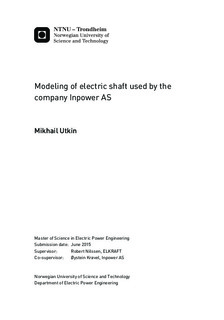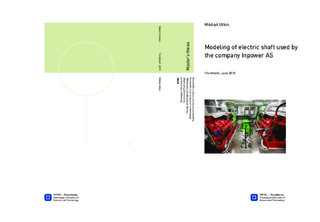| dc.description.abstract | The master thesis is a further investigation of the steady state performance of the direct connection of the permanent magnet generators and motors, used for the ship propulsion; as proposed in the specializing project study conducted in autumn 2014. The challenge is how to implement the possibility of the salient rotor machines in the power flow calculations. Another task is to start the investigation of dynamic system behavior.
In order to cope with the tasks the mathematical models of the steady state systems have been developed, as well as the introductory system for the dynamic studies.
Matlab software has been used for both models. Source code functions implementing developed the mathematical algorithm for the steady state, and block diagram form in the Simulink environment for the dynamic model.
A theoretical review is conducted in order to understand the physics behind the complex mathematical equations. Using the attained theoretical background, an algorithm for solving power flow equations with possibility to include saliency has been developed. In addition the theoretical study of the dynamic system has been presented, explaining in details the usage of blocks in the Simulink model.
In general words, a study case consists of a diesel engine which has a permanent magnet synchronous generator on its shaft, which is directly connected with a three phase alternating current transmission line to the permanent magnet synchronous motor. The motor has a propeller on its shaft which is providing the propulsion of the ship. Ships static load has also been taken into account while modeling, as an adjustable power demand on the terminal bus. The system main difference to the convenient electrical ship propulsion systems is the lack of power electronics in the circuit, thus the system is operating with variable frequency and voltage.
The simulations of the steady state mathematical models show stable results in all range of operation points. The desired accuracy of convergence of the iterative solutions for the nonlinear equations is achieved. The results comparison with a real world tests on board the ship show close values of current for the high frequencies and high power, while for the low frequencies the simulation results are driven away from the tests.
The dynamic system model works as intended and has highlighted the problems of synchronization of the motor and the problem of the torque oscillations on the motor shaft with a fast enough change in load.
Both systems gave insight information and valuable experience of the permanent magnet synchronous machine modeling, starting from the very basic level and avoiding usage of the commercial available software. | |

